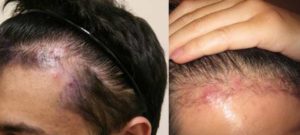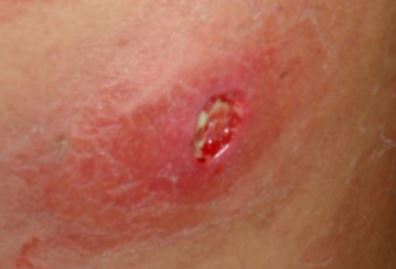It is possible to experience ingrown hair on scalp. Ingrown hair appears as a cyst caused by the damaged hair follicles on the head a condition medically referred to as folliculitis.
In this post, we cover what cause this phenomena, the symptoms and how to treat the condition. We have also provided images to help you understand how the cyst and lumps of ingrown hair looks like.
Ingrown hair is common among those with curly hair. After shaving, the hair becomes sharp. As it grows out, it may curve inwards back to the skin. At the area the hair pierces the skin, it is treated as a foreign object by the immune system. The area may become red and inflamed. The pores may also block, clog with sebum and other dead cells to form a painful itchy bump we are calling an ingrown hair. Ingrown hair can also be caused by wearing clothing that irritates and damage the hair.
Mild case of ingrown hair are consider harmless. However, severe cases of ingrown hair on head can cause scarring and skin discoloration, please seek medical attention for early diagnosis and medication in cases of an underlying medical infections.
Related article:
Ingrown Hair on Scalp and Head- How Does It Feel Like or Appear
The appearance of an ingrown hair can be in two ways. The first way is when the hair grows straight out of the hair follicle then grows back into the skin. This is known as extrafollicular penetration. In practice this may or may not be accompanied by the infection of the hair follicles also known as folliculitis. This is common in people with coarse or curly hair. The ingrown hair may also be accompanied by razor bumps also called (pseudo folliculitis barbae).
The other common known caused of ingrown hair is when the hair grows or develop underneath the skin. The hair is trapped in the skin and does not penetrate through. This is known as transfollicular penetration. Transfollicular penetration is common while tweezing. This leaves the hair fragments under the surface of the skin.
As the hair grows inwards or fails to penetrate the skin, the body will react to the hair as foreign objects. Dead cells will accumulate at the irritated site and form papule. The papule will contain pus as the skin heals to form itchy and irritating cyst.
Other factors that leads to the formation of an ingrown hair include:
- The direction of hair growth and
- Genetic makeup of different people
What are the Symptoms?
Ingrown hair on scalp is common in males than in female. This is most true for those bumps and cyst caused by improper shaving. This s because, men shave often than their female counter parts. For genetic caused ingrown hair, the statics may be equal to both females and males.
In males, it is also common to observe the ingrown hair on chins and armpits. In female, the bumps of ingrown hair can also be seen in armpits, pubic area and along the legs. On scalp, the ingrown hair may be accompanied by the following symptoms.
- Itchy and painful pimple like bumps on scalp
- Dark colored bump head that shows the ingrown hair trapped inside
- The bumps may be filled with pus when infected
- Inflammation and swelling of the bumps
- An uncontrolled urge to scratch the bumps
- Mild to moderate pain along the head
- Frequent lesion
- Some people may have blister like lesions
- Scaring from previous lesions
- Lesions that appear as small round bumps
Mild to moderate cases of the above symptoms can be managed and treated at home. For severe cases, you need to seek immediate medical attention. Topical ointments such as anti-inflammatory and anti-itching creams can be used to relieve the scalp of the itching and inflammation.
Pictures
An ingrown hair on scalp will appear as a bump on head with hair trapped inside. Ingrown hair caused by infected hair follicles also called folliculitis will be filled with pups to form a pimple like bump. The appearance in terms of size, shape and content of the cyst will vary depending on how the ingrown hair was formed. Below we have provided some images to help you understand how the ingrown hair appears.

What Causes Ingrown Hair on Scalp, Head?
Even though the common cause of formation of an ingrown hair is damaged hair follicles, commonly known as folliculitis, other factor like lifestyle activities might contribute to the formation of an ingrown hair on scalp. It thus true to say that the causes of ingrown hair will vary depending on the genetic makeup and the hair removal method adopted.
It is also important to note that anybody can get an ingrown hair. The condition is however common in people with curly or coarse hair. This kind of hair is most likely to bend back and reenter the scalp especially after shaving. The condition is also common to people with high level of sex hormones.
The following are the common known causes of ingrown hair.
1. Extrafollicular penetration
Extrafollicular penetration is a dermatological condition common in men of African ancestry. The condition is also referred to as pseudofolliculitis barbae, it is a common inflammatory follicular disorder characterized by papules and pustules which are bumps like pimples. The condition is generally associated with shaving in men.
Shaving creates sharp edge on the hair, especially if shaving was done when the hair is dry. As the hair grows out, it may curve back and re-enter the skin forming what is commonly known as ingrown hair. This is through extrafollicular penetration.
2. Transfollicular penetrations
Transfolllicular penetration on the other occurs when the hair fails to reach the surface of the skin. Here, the hair grows underneath the skin to form the ingrown hair. This is common while tweezing as the process leaves hair fragments under the surface of the skin. The skin becomes inflamed as the hair finds its way back to the skin surface. This is because, the body detects it as a foreign substance.
3. Poor or improper shaving
Poor shaving is the common cause of ingrown hair in any part of the body. Damaging the hair follicle or sharpening the edges of the hair can cause the hair to penetrate the skin as it grows back. This is common among people with curly hair.
You should ensure the tools used to shave are sharp and do not irritate the skin. Also ensure the hair is moist and not dry when shaving. Shaving creams can also be used after and before shaving.
4. Folliculitis
Folliculitis refers to the damaging or infection of the hair follicles. Folliculitis is a common cause of inflammation of the hair follicles and is known to cause ingrown hair. As the hair follicles becomes inflamed, they may become clog blocking hair from penetrating the skin thus forming an ingrown air on scalp.
The hair follicles may also accumulate pus, dead skin cells and other fluids to form painful and itchy bumps on the surface or beneath the skin as is the case with blind pimple.
5. Direction of hair growth
The direction the hair grows will also greatly contribute to the formation of an ingrown hair. For example, curved hair follicles that produces tightly curled hair will encourage the hair to grow back into the skin forming an ingrown hair.
6. Genetics
Genetic makeup will also contribute to the formation of an ingrown hair. Those with curled hair or those with higher levels of sex hormones will experience faster hair growth rate than the others. This will increase the likelihood of developing an ingrown hair.
Other possible causes
Apart from the above causes, the following might also cause or contribute to the formation of an ingrown hair.
- Lack of skin moisture
- Hirsutism which is the abnormal hair growth on a persons body
- Bacterial and fungal infection causing ingrown hair
- Dry scalp skin causing ingrown hair
- Shaving to close to the skin damaging the hair follicles
- Friction from wearing too tight clothing
Painful Ingrown Hair on Scalp
Painful ingrown hair is a possible sign of infection. This can either be a bacterial infection or viral infection. It is however important to note that most cases of ingrown hair are not serious. For those with health immune system, the pain will clear up on its own within a week or two. For those with weak immune system, the lesions or bumps formed by the ingrown hair will take long. If this is the case please contact your health care provider for medical assistance.
Other symptoms accompanied by the pain will include inflammation and itching. For mild cases, these symptoms can be managed and treated at home. Maintaining high levels of hygiene will be helpful in ensuring the cyst is not infected by either bacteria or any other micro-organism causing infection. Applying aloe Vera gel can also help kill bacteria’s and relive the scalp of the itching and inflammation.
Chamomile tea wash and oatmeal bath can also be helpful in getting rid of the itching, inflammation and swelling in booth children and adults.
The best preventive measure for the ingrown hair is ensuring you adopt hair removal method that do not irritate or damage the hair follicles.
Big Infected Ingrown Hair Cyst on Scalp
A common unwritten rule with ingrown hair is that you should not pop to drain them. Doing so, opens the inside skin for possible bacterial or viral infection. Once infected, an ingrown hair on scalp will produce raised, red bump or a group of them on your head. The bumps will look like pimple but more painful and discomforting.
The infected ingrown hair will a times look like boils. This is especially common when the bumps are filled with pus. The bumps can be very itchy and discomforting especially if you have a lot of them on your head. In children it is common for big infected ingrown hair cyst to rupture, and form scars as they heal.
Another possible cause of a big infected hair cyst is an infected hair follicle. An infected hair follicle will cause the surrounding skin on scalp to get inflamed. The infection can spread deep down the hair follicle resulting in big ingrown hair. The bumps can be beneath the skin or protrude outward to form a pus filled pimple-like bump. If the bumps become too painful and unbearable, do not pop to drain the contents of the bumps. You need to seek medical attention for assistance and medication.
Treatment- How to Cure
As started early, most cases of ingrown hair on scalp are harmless and as such does not warrant immediate medical attention. For mild cases, the symptoms of an ingrown hair can be treated and managed at home. This is because, the symptoms will disappear on their own within a week or two.
For severe cases of the symptoms or in cases of an infected ingrown hair, you need to seek medical attention to prevent the infection from spreading and causing further health damages. Your doctor will prescribe any of the following medicines to treat and manage the symptoms of an ingrown hair.
- Stop removing or shaving until the ingrown hair on your scalp has heal completely. Doing the contrary will only worsen the condition. Scratching and picking the ingrown hair will also make the pain and discomfort worse. It could also lead to a possible skin infection or causes scaring on head.
- Exfoliate to remove dead skin cells is another possible way to treat an infected ingrown hair. Gently wash and exfoliate around the ingrown hair to return the hair to the surface of the skin. If this fails to work, your health care provider will prescribe a drug that dead skin cells slough off more quickly.
Medicines such as retinoid can speed up the clearing of dead skin cell, this medicines can also help clean up dark patches caused by ingrown hair.
- Anti-inflammatory creams and gel can also be helpful in relieving the scalp of the inflammation, itching, swelling and burning sensation caused by ingrown hair on the head. Applying the cream twice in a day should be able to reduce the inflammation. Seek medical attention if the cream is not responsive or you are allergic to it.
- Oral or injectable antibiotics may be prescribe when the ingrown hair causes a bacterial infection or is caused by a bacterial infection. for mild cases of the infection, ointment antibiotic may be used, this can be inform of cream, gel or powder that is applied on the infected ingrown hair on scalp. On the other hand, an oral antibiotic will be prescribed for severe cases of bacterial infection. The antibiotic can also be in form of an injection.
- Anti-itching creams for itchy ingrown hair bumps is the other possible topical ointment used to relieve the scalp of the itching and uncontrolled urged to scratch. Anti-itching creams can be prescribed by the doctor or attained over-the-counter.
To prevent ingrown hair you may also try the following:
- Use a sharp razor when shaving to remove hair from the head. This will help prevent sharp edges that can grow back and penetrate the skin to form an ingrown hair.
- You could consider a laser hair removal method. This method is a long lasting hair removal method. The method is used to remove hair at a deeper level. It is an effective method of preventing hair from growing back. This method should be performed by a profession as added treatment s required over the cause of several months.
- Use alternative hair removal methods. Apart from removing hair by shaving, you could consider using chemical to do so. This can be very irritating to the skin of some people. Some prescription creams can also be used to reduce hair regrowth.
- To reduce skin irritation, you can apply a cool washcloth on the skin after shaving.
- You need to also shave on the same direction the hair is growing to avoid damaging the hair follicle which could result in an ingrown hair.
Best Shampoo for Ingrown Hair on Scalp and Head
Mild antiseptic hair care product can be used in treating the ingrown hair. You need to avoid hair and skin care product that might be too sensitivity the scalp or might cause allergic reaction worsening the condition.
Mild shampoo and other hair care products can be attained over-the-counter. According the characteristics of your hair and how moisturized or dry your scalp is, a professional hair care personal or a dermatologist will be able to prescribe the best shampoo to use for ingrown hair on scalp.
Sources and references


